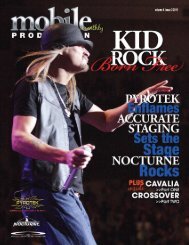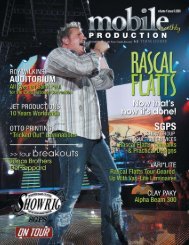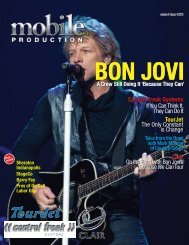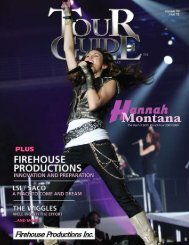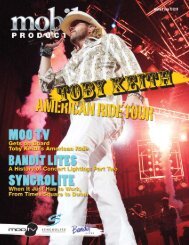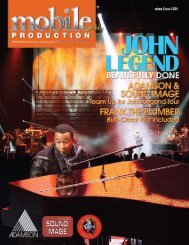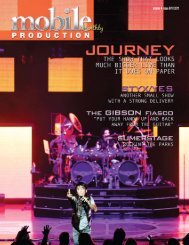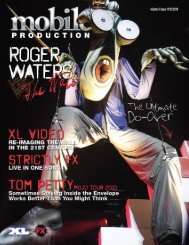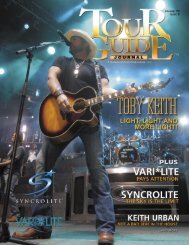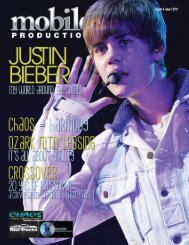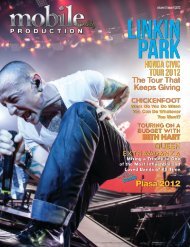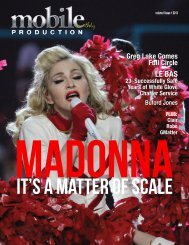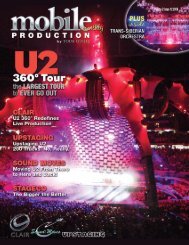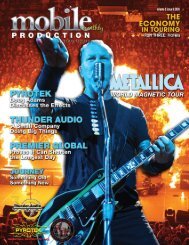volume 2 issue 8 2009 - Mobile Production Pro
volume 2 issue 8 2009 - Mobile Production Pro
volume 2 issue 8 2009 - Mobile Production Pro
Create successful ePaper yourself
Turn your PDF publications into a flip-book with our unique Google optimized e-Paper software.
The<br />
solution<br />
put forth<br />
by Terry<br />
“Cowboy”<br />
Parker and<br />
the big brains<br />
at SGPS was<br />
elegant. Cowboy<br />
explained, “We had<br />
to get the weight out<br />
from the middle of the<br />
room, and a large part<br />
of that weight was in the<br />
winches that we were used<br />
for the automated lighting and<br />
video moves. So we built theatrical<br />
lines sets that allowed us to lift<br />
the loads from directly above while<br />
placing the winches out at the perimeter<br />
of the grid.”<br />
If there were an unwanted side effect of<br />
this system it’s that they wound up using<br />
twice the cable as if they had placed the<br />
winches directly over the load. As a<br />
result, it took about an hour to string<br />
the line sets up every day, but that<br />
was an easy trade off to make.<br />
None of the stage could be built<br />
in one piece while the mother<br />
grid and the flown systems<br />
were being built because the<br />
stage and the gear in the air<br />
took up the same amount<br />
of space, which is to say<br />
they took up the majority<br />
of the floor. The result<br />
was that the stages had<br />
to be put together in sections<br />
and put together<br />
when everything was<br />
flown into place. Even<br />
the B stages were built<br />
in sections and pieced<br />
together when they were<br />
finally positioned for the<br />
show.<br />
As one could well imagine, the<br />
primary bulk of the rig hung<br />
over the main stage. Much of<br />
the lighting was provided off<br />
six “V” trusses that pointed<br />
in toward a circular truss that<br />
anchored the look. Inside the<br />
circular truss were three concentrically<br />
placed circular<br />
video walls.<br />
At the beginning of the<br />
show the main lighting<br />
rig was flown in to the<br />
stage with the outside<br />
of the “V” trusses<br />
angled down toward<br />
the crowd. The<br />
video rings were<br />
likewise at stage level and tucked inside one<br />
another. The show opened with a laser shot<br />
that presented the Jonas Brothers logo on the<br />
B stages as the lighting and video systems flew<br />
up into position. In typical dramatic fashion,<br />
the Jonas Brothers entered through a lift in the<br />
center of the stage, and the night was off and<br />
running.<br />
While the show was gag heavy and more of<br />
the impressive gags were executed on the B<br />
stages, the main stage was action central both<br />
on and below the deck. The stage had a lift at<br />
its center that also rotated. This was the means<br />
by which the guys entered the show. However,<br />
other passengers of the show were a baby<br />
grand piano, which was used at two different<br />
times during the night as well as a spare drum<br />
set.<br />
One of the more extraordinary gags of the<br />
night (albeit terrifying) was when a trampoline<br />
skin was stretched across the opening to the<br />
lift and the guys did some fairly impressive<br />
acrobatics on it. And while the gag itself was<br />
impressive enough to the crowd, what was<br />
striking to this writer (and we suspect to mPm<br />
readers) was that it had to be deployed directly<br />
after the piano was used. This meant that the<br />
piano had to come down and be removed and<br />
stowed, and the trampoline had to be deployed<br />
all in a matter of 30 seconds. It had to be done<br />
right. If there was anything wrong with the<br />
tramp it wouldn’t be known until everyone’s<br />
worst nightmare came true.<br />
Because of the amount of automation being<br />
used in the stage, there were several people<br />
stationed in its belly running and watching the<br />
automation. Add that number to the backline<br />
techs and musicians down there, at any given<br />
time you could have as many as 30 people<br />
working in a very tight environment.<br />
One interesting part of the show was that<br />
there were gags that only happened on one<br />
end of the show or the other. On one of the<br />
B stages was a spectacular water feature called<br />
Water Screen presented by Toronto<br />
based Auqua Visual F/X, Inc., which<br />
is a sister company of Pyrotek. As was<br />
stated in last year’s O Canada <strong>issue</strong>, this effect<br />
is a computerized rain system that is able to<br />
precisely control water output in order to present<br />
intricate graphics in the stream. The application<br />
in the show was a ring that hung directly<br />
over the outside rim of the stage. Lighting<br />
Designer/Show Designer/Lighting Director<br />
John Labriola hit the water in lavender light<br />
from top and bottom provided by LED units<br />
positioned just inside the nozzles.<br />
The programming of the water output was<br />
so precise that the varying size of the drops<br />
was able to give the graphic images depth.<br />
This was a little complicated because when<br />
they were putting up symbols like hearts in the<br />
display, they could place them anywhere in<br />
the stream they wanted because they wouldn’t<br />
interfere with the image on the other side of<br />
the aquatic cylinder as seen through the display.<br />
On the other hand, text was a little less visually<br />
innocuous. Shapes and icons look the same<br />
no matter how you look at them, but text is<br />
another story all together. If there was text<br />
like a song lyric on one side of the display it<br />
couldn’t show up on the other side at the same<br />
time, or it would have conflicted with itself.<br />
Therefore, it had to be offset in the stream by<br />
several feet. Once all of this was sorted out, the<br />
only thing left was to add the Jonas Brothers to<br />
the effect. As the water was falling, they played<br />
inside of it in a sort of 21 st century rock ‘n’ roll<br />
version of “Singing in the Rain.” The effect<br />
was incredible.<br />
photos by Michael A Beck<br />
mobile production monthly 21



